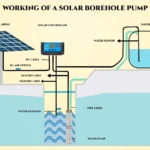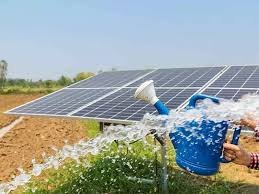With the rising cost of electricity and the need for sustainable energy sources, solar-powered borehole systems have become an efficient and eco-friendly solution for water supply in Kenya. Solar borehole pumps harness the sun’s energy to pump water from underground, eliminating dependence on the national grid and reducing operational costs. This article explores the benefits, installation process, and maintenance of solar borehole systems.
Borehole solarization is a cost-effective and environmentally friendly way to power borehole water pumping systems. By using solar energy, borehole solarization eliminates the need for grid electricity or diesel generators, reducing operational costs and ensuring uninterrupted water supply, even in remote areas. Below are the key components of borehole solarization:
Powering the Borehole with Solar Energy
Switching to solar-powered borehole systems provides sustainable, reliable, and energy-efficient water extraction. The process includes:
- Assessing water demand and site conditions to determine the required solar power capacity.
- Installing solar panels and inverters to convert sunlight into electricity.
- Integrating a solar water pump designed to operate efficiently with solar energy.
Solar-powered boreholes are ideal for off-grid locations, farms, and rural communities, ensuring a consistent water supply without high energy costs.
Sale of High-Quality Solar Panels
Solar panels are the backbone of any solarized borehole system, as they capture sunlight and generate the energy needed for water pumping. Our high-quality solar panels are:
- Durable and weather-resistant, capable of withstanding harsh conditions.
- High-efficiency models, ensuring maximum energy generation.
- Compatible with borehole pump systems, offering seamless integration.
Investing in the right solar panels ensures long-term performance, reduced maintenance, and consistent energy supply.
Sale of Solar Inverters
A solar inverter is crucial in borehole solarization, as it converts DC (direct current) from solar panels into AC (alternating current) required to power borehole pumps. Our solar inverters offer:
- High energy conversion efficiency, minimizing energy loss.
- Smart control features, allowing remote monitoring and system adjustments.
- Compatibility with different pump capacities, ensuring a stable power supply.
Choosing the right solar inverter enhances system reliability, reduces energy waste, and improves water pumping efficiency.
Why Choose Solar Energy for Boreholes?
1. Cost-Effective & Energy-Efficient
Traditional electric or diesel-powered boreholes incur high running costs due to fluctuating fuel prices and electricity bills. In contrast, solar borehole pumps utilize free solar energy, reducing operational expenses over time.
2. Reliable Water Supply in Remote Areas
Many rural areas in Kenya lack reliable grid electricity. Solar borehole systems provide a dependable water source for households, agriculture, and livestock, ensuring year-round access to clean water.
3. Environmentally Friendly
Solar-powered boreholes contribute to a greener environment by reducing carbon footprints and eliminating the pollution associated with diesel generators.
How Solar Borehole Systems Work
A solar-powered borehole system consists of several key components:
1. Solar Panels
These panels absorb sunlight and convert it into electricity to power the borehole pump.
2. Solar Inverter (Optional)
Converts direct current (DC) from the solar panels into alternating current (AC) for certain pump types.
3. Borehole Pump
Pumps water from underground and delivers it to storage tanks or directly to the point of use.
4. Storage Tank (Optional)
Stores water for use when sunlight is unavailable.

Steps to Install a Solar Borehole System
How to install a Solar Borehole System
Installing a solar borehole system involves several crucial steps to ensure efficiency and reliability. From site assessment to final commissioning, each stage requires careful planning and professional execution. Below is a breakdown of the process to guide you through a seamless installation.

Steps Required
A professional borehole drilling and solar installation expert will evaluate the location to determine sunlight availability, water depth, and pump capacity requirements.
Choosing the right solar pump, panel capacity, and water storage system is crucial for efficiency.
The panels are strategically placed for maximum sun exposure, usually on rooftops or ground-mounted frames.
The borehole pump is connected to the solar panel system, ensuring it receives adequate power for operation.
Once installed, the system is tested to ensure optimal functionality.
Maintenance Tips for Solar Borehole Systems
Proper borehole maintenance extends the lifespan of your system and ensures efficiency.
1. Regular Cleaning of Solar Panels
Dust and debris can reduce panel efficiency. Clean them periodically to maintain optimal performance.
2. Checking Pump Efficiency
Monitor water pressure and output to detect any pump issues early.
3. Inspecting Electrical Connections
Ensure all wires and connections remain intact and secure.
4. Preventing Water Contamination
Regularly test water quality to avoid contamination and ensure safe usage.

